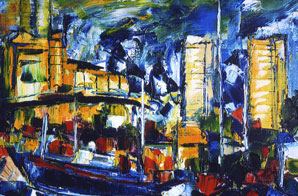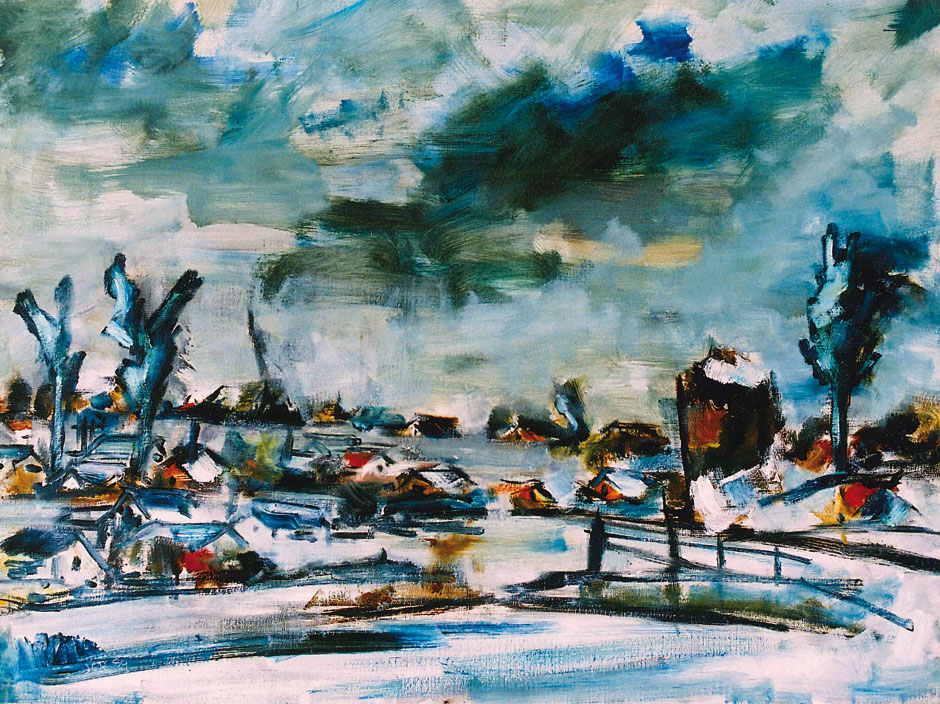Scroll down or click for “the story behind the story” of how Chu Teh-Chun and Hubert Roestenburg met. (further down, East meets West, a surprising tale of two paintings).
Chu Teh-Chun and Hubert Roestenburg side by side in CHRISTIE’S 2014 ASIAN 20th CENTURY ART catalog
Finding a picture of a Hubert Roestenburg painting next to a Chu Teh-Chun painting in Christie’s catalog caused a bit of a stir among the visitors of a Christie’s auction in Hong Kong last fall. Not too many people there were familiar with the work of Hubert Roestenburg. Afterall Chu Teh-Chun was the main course at the ASIAN 20th CENTURY ART Day Sale held on November 23 in Hong Kong. “Who is this Hubert Roestenburg?”, was quietly whispered among some of the guests attending the auction.
Chu Teh-Chun has been getting record-setting prices in the last few years, so expectations were high. In November of 2013, an untitled oil painting by Chu Teh-Chun sold at an auction in Hong Kong for US$ 9.1 million. In 2012 a Chu Teh-Chun painting sold for US$ 7.7 million, which makes Chu Teh-Chun one of the three highest priced Chinese artists of all time. Some of the most valued Chu Teh-Chun paintings are the ones he painted after he gained a deeper understanding of German Expressionism. Most Chu Teh-Chun paintings at the auction in Hong Kong were of that period; after German Expressionism became a major influence on his work. Christie’s curator writes in the auction catalog: “Chu’s No. 467 establishes the foundation for his painting style during the ’70s.” (it’s painting no 467 that is linked in the catalog to the Roestenburg painting Autumn near London).
The plot thickens…
Chu Teh-Chun started visiting Germany in the early seventies and that’s where the plot thickens. He visits several Hubert Roestenburg exhibitions over the years although Roestenburg himself was not aware of that until recently. Even during his last visit to a Hubert Roestenburg Exhibition in 2006, it was unclear to Roestenburg who this elderly Chinese gentleman was. As Roestenburg tells it; Mr. Chu politely asked if he could take photographs. After getting permission to do so, he stayed for over two hours, taking photographs the whole time. “At some point I offered him a chair, and my wife brought him coffee”, says Roestenburg, “He seemed so fragile”.
When Hubert Roestenburg learned of the death of Chu Teh-Chun in March of 2014 and saw a picture of him, he immediately recognized the man in the photograph as the Chinese gentleman who would sometimes visit his shows. “On his last visit he actually introduced himself as a fellow painter”, says Roestenburg, “But the name didn’t ring a bell and it’s not at all unusual to have other painters visit my shows. It was also quite busy that day, so I didn’t have time to chat with him. I was sad to hear of his demise. It’s as if I lost a friend, I never knew I had.”
christies.com/lotfinder/paintings/chu-teh-chun-paul-cezanne
christies.com/lotfinder/paintings/chu-teh-chun-hubert-roestenburg
Chu Teh-Chun, a look at his painting style.
It’s very interesting to see how Chu Teh-Chun’s style changes throughout his long career. Although we can see major changes in his painting style, his goal seems to always be the same. Christie’s curator says it best (page 10). ” If we take an analytical view towards Chu Teh-Chun’s reverence for the painters Goya, El Greco, and Rembrandt, we can infer that his goal was to use light and shadow to achieve the same kind of infectious, dramatic qualities. Each of those three artists-Rembrandt, Goya in The Shootings of May Third, 1808 (Fig. 4), and El Greco in View of Toledo (Fig. 5) depicted their subjects with brilliant contrasts of light and shadow. A study of the contrasts of light and shadow occupied Chu during the ’70s”.
Chu Teh-Chun, Goya, El Greco, Hubert Roestenburg
On the left (Fig.1) we see an early Chu Teh-Chun painting. On the far right (Fig.2) we see a later Chu Teh-Chun painting. The painting on the right (Fig.2) was done after he becomes interested in German Expressionism. In between, Goya – The Shootings of May Third (Fig.4), El Greco – View of Toledo (Fig.5) and Hubert Roestenburg – Autumn near London (Fig.3). This line-up gives us a good sence of how Chu Teh-Chun grows through his long career. Click image to enlarge
Click image to enlarge
Click images to enlarge
Hubert Roestenburg and Chu Teh-Chun. A tale of 2 paintings (one is a lithograph).
On the left a Hubert Roestenburg landscape painting. On the right a lithograph by Chu Teh Chun. It’s fascinating to see how these two masters interpret what is essentially the same landscape. It’s also interesting to examine how both artists arrive at their respective artistic destinations.
Hubert Roestenburg was practically an expressionist from birth. It’s his nature. He gains early fame as a child prodigy. When he is just fifteen years old, he holds his first exhibit. Critics who discover this “boy wonder” immediately label him “the second van Gogh”.
He eventually leaves The Netherlands, where he was born, to escape this stigma. Although he manages to lose the moniker he so despises, the ghost of van Gogh stays with him for the rest of his life. A kind of opposites-attract relationship. Where van Gogh struggles all his life to stay in control of his demons, Roestenburg seems to embrace every emotion and every experience. It’s what drives his art. The results can be a painting like the one above.
Chu Teh-Chun arrives at a similar destination via an entirely different route.
At a very young age, Chu was exposed to many famous paintings and calligraphic works. These influences remain at the core of Chu’s art. Philosophically and spiritually Chu Teh-Chun is a poet and a dreamer. In spite of European influences, notably German Expressionism and individual artists such as Rembrant and Nicolas de Staël, Chu remains a true Chinese landscape painter. Chu Teh-Chun once said, “the essence of Chinese landscape painting is in one word: ease, both in technique and in the ideal mindset of the artist”. Traditionally that mindset is meditative, reflective and deliberate. It can result in the lithograph seen above. After seeing paintings by Chu, French art critic, Pierre Cabanne said “real painting results from memory.”
That’s not how Hubert Roestenburg approaches painting. Roestenburg has to stand outside in the field, fully engaged both physically and emotionally. He has to smell the landscape and feel the weather, in other words, a total experience of time and place. That’s why these the works above are similar only in a superficial way, The Chu Teh-Chun lithograph is an exquisite meditation. The Hubert Roestenburg painting is a representation of an emotional state, a recording of what he himself once called, “an uncontrollable experience”.
note: because of it’s larger than usual size, the uncomfortable weather and the high attention to detail; the making this painting was particularly taxing to Mr. Roestenburg. As he was packing up he was overcome with exhaustion and collapsed, taking the wet painting with him to the ground. You can still find some Alp grass embedded in the paint.
Click images to enlarge and to learn more about each individual painting




















